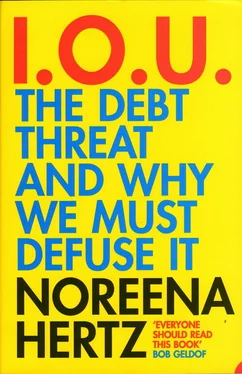After Volcker came Rockefeller, the wise old man of Wall Street, and former Chairman of Chase Manhattan Bank. ‘That meeting went really well,’ Bobby remembers. ‘We discussed then-current initiatives, and the problems with these. We corresponded back and forth for several months.’ And after Rockefeller came Holbrooke and after Holbrooke, Bob Hormats, Vice Chairman of Goldman Sachs.
Bono and Bobby were ready to hit DC.
Robert Rubin, the US Treasury Secretary at the time, was evasive. ‘I just couldn’t get to him,’ recounts Bono. ‘I even said I would swim to wherever he was at one point.’ Rubin was a devotee of Alexander Hamilton, America’s first Treasury Secretary, who famously insisted after the War of Independence that the individual states repay all their debt. Rubin, not surprisingly, was dead set against debt cancellation. But when they did eventually meet, thanks to Hillary Clinton’s intervention, Rubin, although clearly never going to be an advocate, indicated that he would not stand in their way.
Word got to Bono and Shriver that Larry Summers, the Treasury Secretary-in-waiting might be more proactive. Summers had formerly been the Chief Economist at the World Bank, and development was a known passion of his. But, again, just getting the meeting wasn’t easy.
‘I didn’t particularly see why I had to hang out with a singer I’d never heard of,’ Summers recounts. ‘But the young women on my staff told me I had to see him.’
‘It’s true. Larry had no idea who Bono was, nor had he heard of U2,’ confirms Sheryl Sandberg, Summers’ Chief of Staff at the time. ‘It was a cause of great hilarity in the office. But I was his Chief of Staff, which meant that requests came through me, and I would then make recommendations as to who the Secretary should or should not see. As a cabinet member, your time is the only commodity you have, so we took the scheduling process very seriously. And when this request came in, I was like, we’re doing this meeting, we’re not going to have a normal conversation.’
But Summers wanted to lie low. About to be sworn in as Treasury Secretary, the last thing he needed was a gossip item about him meeting a pop star, perfect ammunition for his political enemies already labelling him a liberal flake. The meeting could not take place in his office. Instead, it was set up in the White House offices of Gene Sperling, the Head of the National Economic Council, across the street from the Treasury.
‘There were about six of us round the table when Bono walked in, wearing jeans and sunglasses, which is not what you’d expect in the White House,’ recounts Sandberg, ‘especially as Larry didn’t really get that he’s, like, a rock star.’
‘I didn’t feel I had a very good meeting with Larry,’ says Bono now. ‘I didn’t think the pitch went very well. It wasn’t one of my better days, and he was drumming on the table with his fingers while I was talking, distracted.’
But those at the meeting remember it differently. Stephanie Flanders, Summers’ former speech writer was impressed. ‘He was massively informed on the subject,’ she recalls of Bono. ‘He was referring to a lot of turgid studies – documents on the debt issue, reports for Congress. Everyone was really impressed.’
Sandberg agrees: ‘He knew what all the acronyms were, he knew how the debt flows worked, he knew about capital risk.’ Summers himself sums it up: ‘He turned out to actually know a ton about debt.’
Finally, when the meeting was winding down, Bono, looking Summers straight in the eye, said: ‘I’ve been all over the world, and every single person says if I can get Larry Summers, I can get this done. Because if he wants this done, it’ll be done. So I’m here to get you. ’
Sandberg remembers the surprise on the faces around the table. ‘It was kind of just like, whoa,’ she recalls. ‘Very few people come in with that much force and speak to the Secretary of the Treasury in that way. And it was very inspirational. I think we all wanted to believe that something like this could happen, that it was worth fighting for.’
‘Bono had an effect on me,’ admits Summers. ‘His presence suggested there was a big constituency out there who cared about debt.’ So although his response at the meeting was a non-committal – ‘let me think about it’ – Summers turned to Flanders when Bono had left the room, and said: ‘I think the Administration has just had its consciousness raised. This guy’s right. We have to fix this.’
The first step was getting then President Bill Clinton to pledge to cancel 100 per cent of the debts owed to the US by the world’s poorest countries – a goal that Professor Sachs had persuaded Bono to push for. Although various debt-relief programmes had been in place for the past few years, thanks largely to the British Treasury’s championing of the cause, they had only required that creditors cancel a percentage of what they were owed, rather than the whole amount. Debtor countries, therefore, never actually received what they needed to become solvent.
One hundred per cent debt cancellation would send a clear signal to the international community that the to-ing and fro-ing on debt relief wasn’t working. It would also set the standard for other creditors to follow suit.
‘Cancellation,’ not ‘relief of the debt was a distinction that had been made explicit a few months before, after Bono met with Sandy Berger, Clinton’s National Security Adviser, the morning the US had gone into Kosovo. ‘He hadn’t been to bed,’ Bono remembers. ‘He’d been up all night, he was bleary-eyed, and Clinton had sent me down to meet him, you know talk to him about it. So I’m sitting there and he was scrunching his red eyes, saying, “Run that by me again? Debt relief, debt relief. God, that just sounds so wrong in this environment. You’re a songwriter – can’t you come up with something better than that?” And I said, “Debt Cancellation,” and he said, “That’s better. Relief sounds like a handout. Cancellation sounds like justice.”’
Selling the idea of cancelling debt to Clinton wasn’t hard. The President had just come back from the G8 meeting of the richest developed nations in Cologne, where debt relief had been high on the agenda. He had already pledged to contribute to funding the IMF and World Bank’s debt relief efforts, and also to increase the amount of American debt that would be cancelled. But cancelling all the debts owed to the US was another matter. Could the United States really afford it?
It was up to Summers to convince the President.
‘I remember a frantic weekend in which Larry, Gene [Sperling who’d facilitated the first meeting with Summers] and Gene’s niece who he was minding, had come in on the Saturday to do the numbers and try to make it happen,’ recounts Bono. ‘Busy, busy people coming in on a Saturday to get shouted at and reasoned with. Trying to work out what it’d actually cost to cancel these debts. The extent to which they could be written down so that we could meet the 100 per cent cancellation objective.’ (For, given that there was no real possibility of their ever being repaid in full, these debts could be discounted so as to reflect a realistic market value.)
‘And we did it,’ says Summers with a smile. ‘In the last 36 hours we worked out that we could afford to do this.’ By writing down the value of their loans by approximately 90 per cent, the real cost to the United States of cancelling the $6 billion debts owed would only amount to around $600 million.
On September 29, 1999, at a speech at the World Bank, with Summers’ numbers in his back pocket, President Clinton announced that the United States would cancel 100 per cent of the $6 billion debt owed it by the world’s poorest 33 countries – the first country in the world to make such a huge commitment.
Читать дальше












